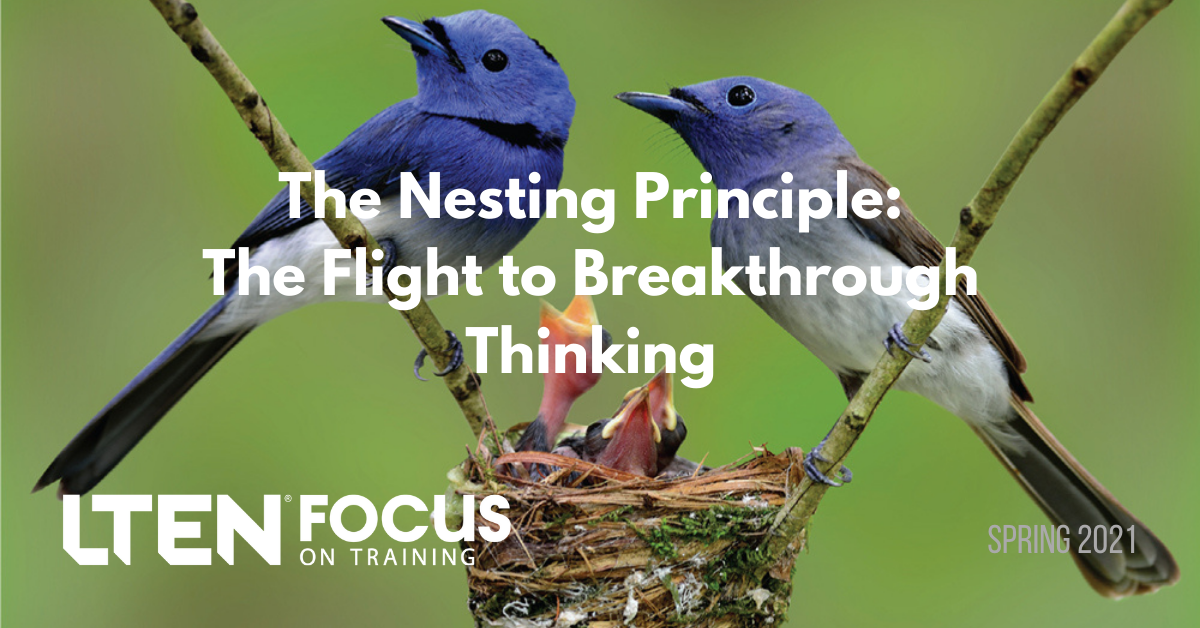
The Nesting Principle: The Flight to Breakthrough Thinking
Feature Story – By Philip Sigler
 How do sticks, twigs and office chairs prevent us from breaking out of the nest and truly flying? The answer is “The Nesting Principle.”
How do sticks, twigs and office chairs prevent us from breaking out of the nest and truly flying? The answer is “The Nesting Principle.”
The nesting principle addresses the paradox that exists in us as human beings: While we need to create an environment that is safe and secure, that same need prevents us from achieving our highest capacities and potentials. I base the nesting principle on more than 20 years of observations from multiple corporate roles, primarily sales training, and from extensive work with meeting planning teams.
I discovered the nesting principle as a facilitator in a training department, working with newly hired sales representatives. Every day the representatives would come in, drop their backpacks by their chairs, break open their binders and cheerfully jump into that day’s program. This continued into the second week when it awned on me that the representatives were always sitting in the same seats at the same tables. Nobody ever changed seats. Ever.
The astonishing part of the nesting principle occurred a few months later when the group returned to continue the training. We were assigned a different training room, and as the representatives entered, they all took up the same seats relative to where they had sat in the training room from three months before. They were in a different room at a later time, yet they sat in the same proximity as before! They had successfully built permanent nests.
The Four Stages of Nesting
Nesting is broken down into four stages: search, build, strengthen and insulate. Nesting varies based on circumstances and the perceived risk we feel in our environment. Research shows that 91.4% of our fears are never realized, so we are often building nests for risks that do not materialize.
1. Search: Where can I establish a safe place in my environment?
The first thing we do is scope out the environment for our stronghold. This happens quickly in our home and work environments, occurring within seconds. The level of conscious involvement in our nesting search depends on the level of uncertainty we feel in any situation.
2. Build: What do I need as the foundation for my chosen space?
Once our search is complete, we inventory our surroundings. The physical phase of Build is evident, placing our materials in a comfortable and secure manner. The mental phase is less evident yet more impactful. We scan our immediate environment, identify threats and securities, and establish our safe proximity to those around us.
3. Strengthen: How do I make this space more secure?
Now that our nest is built, we will reinforce our space within our community so we can elevate our performance and secure our standing. We will encourage those around us with high-fives and enthusiastic applause, even coming up with a team name to solidify our unification. We now have the mindset to thrive.
4. Insulate: How can I minimize intrusion from future threats?
We secure our nest and protect our environment by establishing filters and biases. Colleagues must remain in their expected roles. Meetings must be held in a predictable manner. We establish standards, such as, “That’s the way we’ve always done it,” and the ever popular, “It is what it is.” All subsequent experiences are funneled through our expectations, biases and assumptions. While we achieve a certain amount of success in this environment, the opportunity to create something even better is minimized.
The Social Branch
Nesting expands to the social level. Along with building our nests to establish security, it is equally imperative that those around us build their nests in relative proximity to where we expect them to. The social branch of the nesting principle emerged when I attended a training event as a participant.
Late in the day, I voluntarily moved to a table where an empty space was available with another group. My classmates immediately remarked on my move, jokingly asking if they were “no longer worthy” and if I had “found new friends.”
Their responses were unexpectedly unnerving. I had a hard time focusing the rest of the day. This didn’t happen only the one time. In the name of social science experimentation, I have summoned the courage to make this move at numerous meetings and training events, resulting in the same responses. Every time.
I conducted the nesting experiment on an even larger scale, being a participant in a two-day training seminar. The class was at capacity and I established my nest in the third row. I reviewed the room and made note of where everyone was seated.
On the second day I waited until everyone had been seated before I entered the room. Sure enough, only my seat from the previous day was available. I scanned the room and 38 of the 40 participants were sitting in the same seat as they had the day before. The two who had moved did so for professional reasons.
We establish our nest and will not deviate from it unless an internal need and/or external force mandates it. With awareness, we can break out of the nest on our own and create breakthrough thinking.
Breaking Out of the Nest
Build your ability to grow and thrive by breaking out of your nest. Don’t destroy it, mind you, but take small steps toward expanding your vision:
- Change the way you hold your next meeting.
- Set the time of the meeting to start five minutes past the hour and/or end five minutes before the subsequent hour.
- At some point have attendees stand up and rotate two chairs to the right. They will literally have a new perspective in the room.
Also, take lunch differently. How we take lunch is a huge nesting illustration: Teams of individuals will converge onto pre-selected tables and sit in the same spot relative to their colleagues. Every day.
Once my team inadvertently sat at what was clearly a nesting lunch table for one of our counterpart teams. Although the nesters proclaimed that it was no big deal — ha, ha — and that we were free to sit at their table — chuckle, chortle — one of them brought it up two days later at a presentation they were facilitating, noting from the front of the room how his team had been bumped from their designated lunch space.
Bust out of the nest! Change some habits! To create breakthrough thinking, we need to take an objective look at what we have built around us, in our physical space as well as our established biases. We should question our processes and think outside the nest.
A few questions to ask are:
- How is my nest preventing me from achieving my goals?
- Whom do I trust to provide me objective feedback on where I am stuck?
- How can we as a team give each other permission to explore creative options to a challenge?
 Bonus Focus Article
Bonus Focus Article
For more information on breakthrough thinking, check out my companion article, Practical Applications for Breakthrough Thinking, published to the LTEN Bonus Focus section at www.lten.org/bonusfocus/jan2021_breakthrough_thinking_applications/ for ideas on breaking out of the nest.
Philip Sigler is director, talent strategy & development, for Sumitomo Dainippon Pharma America (SDPA). Email Phil at philip.sigler@sdpa.com. The commentary in this article does not necessarily reflect the policies, views or opinions of SDPA.








